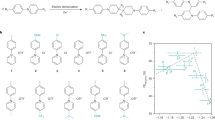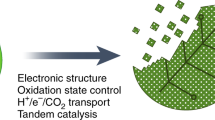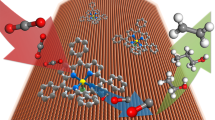Abstract
The most energy-efficient electrocatalysts mediate forward and reverse reactions at high rates with minimal overpotential requirements. Such electrocatalytic reversibility is commonly observed for redox enzymes and is an attribute that we have sought to bestow on synthetic molecules to realize highly active and robust catalysts for applications in renewable energy. The recent development of the first synthetic molecular catalysts that reversibly mediate H2 ⇌ 2 H+ + 2e− exploits an enzyme-inspired outer coordination sphere that works in concert with both first and second coordination spheres. In this Perspective, we discuss a series of molecular Ni catalysts for H2 production and oxidation that exhibit electrochemical reversibility. Study of these catalysts allows us to identify important first, second and outer coordination sphere features necessary for efficient conversions of H2 and provides direction for the rational design of electrocatalysts that operate on other small molecules.
This is a preview of subscription content, access via your institution
Access options
Access Nature and 54 other Nature Portfolio journals
Get Nature+, our best-value online-access subscription
$29.99 / 30 days
cancel any time
Subscribe to this journal
Receive 12 digital issues and online access to articles
$119.00 per year
only $9.92 per issue
Buy this article
- Purchase on Springer Link
- Instant access to full article PDF
Prices may be subject to local taxes which are calculated during checkout








Similar content being viewed by others
References
Lewis, N. S. & Nocera, D. G. Powering the planet: chemical challenges in solar energy utilization. Proc. Natl Acad. Sci. USA 103, 15729–15735 (2006).
Lewis, N. S. & Nocera, D. G. The solar opportunity. Bridge 45, 41–47 (2015).
Nocera, D. G. Chemistry of personalized solar energy. Inorg. Chem. 48, 10001–10017 (2009).
Nocera, D. G. The artificial leaf. Acc. Chem. Res. 45, 767–776 (2012).
Nocera, D. G. Solar fuels and solar chemicals industry. Acc. Chem. Res. 50, 616–619 (2017).
Pegis, M. L., Wise, C. F., Martin, D. J. & Mayer, J. M. Oxygen reduction by homogeneous molecular catalysts and electrocatalysts. Chem. Rev. 118, 2340–2391 (2018).
Bourrez, M., Molton, F., Chardon-Noblat, S. & Deronzier, A. [Mn(bipyridyl)(CO)3Br]: an abundant metal carbonyl complex as efficient electrocatalyst for CO2 reduction. Angew. Chem. Int. Ed. 50, 9903–9906 (2011).
Lubitz, W., Ogata, H., Rüdiger, O. & Reijerse, E. Hydrogenases. Chem. Rev. 114, 4081–4148 (2014).
Fontecilla-Camps, J. C., Volbeda, A., Cavazza, C. & Nicolet, Y. Structure/function relationships of [NiFe]- and [FeFe]-hydrogenases. Chem. Rev. 107, 4273–4303 (2007).
Jones, A. K., Sillery, E., Albracht, S. P. J. & Armstrong, F. A. Direct comparison of the electrocatalytic oxidation of hydrogen by an enzyme and a platinum catalyst. Chem. Commun. 866–867 (2002).
Knörzer, P. et al. Importance of the protein framework for catalytic activity of [FeFe]-hydrogenases. J. Biol. Chem. 287, 1489–1499 (2012).
Armstrong, F. A. & Hirst, J. Reversibility and efficiency in electrocatalytic energy conversion and lessons from enzymes. Proc. Natl Acad. Sci. USA 108, 14049–14054 (2011).
Pandey, A. S., Harris, T. V., Giles, L. J., Peters, J. W. & Szilagyi, R. K. Dithiomethylether as a ligand in the hydrogenase H-cluster. J. Am. Chem. Soc. 130, 4533–4540 (2008).
Abou Hamdan, A. et al. Understanding and tuning the catalytic bias of hydrogenase. J. Am. Chem. Soc. 134, 8368–8371 (2012).
Bachmeier, A. & Armstrong, F. Solar-driven proton and carbon dioxide reduction to fuels — lessons from metalloenzymes. Curr. Opin. Chem. Biol. 25, 141–151 (2015).
Faunce, T. A. et al. Energy and environment policy case for a global project on artificial photosynthesis. Energy Environ. Sci. 6, 695–698 (2013).
Xu, L. & Armstrong, F. A. Pushing the limits for enzyme-based membrane-less hydrogen fuel cells — achieving useful power and stability. RSC Adv. 5, 3649–3656 (2014).
Gloaguen, F. & Rauchfuss, T. B. Small molecule mimics of hydrogenases: hydrides and redox. Chem. Soc. Rev. 38, 100–108 (2009).
Simmons, T. R., Berggren, G., Bacchi, M., Fontecave, M. & Artero, V. Mimicking hydrogenases: from biomimetics to artificial enzymes. Coord. Chem. Rev. 270–271, 127–150 (2014).
Barton, B. E., Whaley, C. M., Rauchfuss, T. B. & Gray, D. L. Nickel–iron dithiolato hydrides relevant to the [NiFe]-hydrogenase active site. J. Am. Chem. Soc. 131, 6942–6943 (2009).
Darensbourg, M. Y. Hydrogenase active sites: a new paradigm for natural product-inspired synthesis based on organometallic chemistry. Comments Inorg. Chem. 31, 144–152 (2010).
Gan, L. et al. A nickel phosphine complex as a fast and efficient hydrogen production catalyst. J. Am. Chem. Soc. 137, 1109–1115 (2015).
Gärtner, F. et al. Light-driven hydrogen generation: efficient iron-based water reduction catalysts. Angew. Chem. Int. Ed. 48, 9962–9965 (2009).
Goldsmith, J. I., Hudson, W. R., Lowry, M. S., Anderson, T. H. & Bernhard, S. Discovery and high-throughput screening of heteroleptic iridium complexes for photoinduced hydrogen production. J. Am. Chem. Soc. 127, 7502–7510 (2005).
Guttentag, M. et al. Photocatalytic H2 production with a rhenium/cobalt system in water under acidic conditions. Eur. J. Inorg. Chem. 2012, 59–64 (2012).
Hsieh, C.-H. et al. Redox active iron nitrosyl units in proton reduction electrocatalysis. Nat. Commun. 5, 3684 (2014).
Hsieh, C.-H. et al. Structural and spectroscopic features of mixed valent FeIIFeI complexes and factors related to the rotated configuration of diiron hydrogenase. J. Am. Chem. Soc. 134, 13089–13102 (2012).
Leung, C.-F. et al. A cobalt(II) quaterpyridine complex as a visible light-driven catalyst for both water oxidation and reduction. Energy Environ. Sci. 5, 7903–7907 (2012).
Liu, T. & Darensbourg, M. Y. A mixed-valent, Fe(II)Fe(I), diiron complex reproduces the unique rotated state of the [FeFe]hydrogenase active site. J. Am. Chem. Soc. 129, 7008–7009 (2007).
Lomoth, R. & Ott, S. Introducing a dark reaction to photochemistry: photocatalytic hydrogen from [FeFe] hydrogenase active site model complexes. Dalton Trans. 9952–9959 (2009).
Probst, B., Guttentag, M., Rodenberg, A., Hamm, P. & Alberto, R. Photocatalytic H2 production from water with rhenium and cobalt complexes. Inorg. Chem. 50, 3404–3412 (2011).
Schilter, D., Camara, J. M., Huynh, M. T., Hammes-Schiffer, S. & Rauchfuss, T. B. Hydrogenase enzymes and their synthetic models: the role of metal hydrides. Chem. Rev. 116, 8693–8749 (2016).
Ulloa, O. A. et al. Mechanism of H2 production by models for the [NiFe]-hydrogenases: role of reduced hydrides. J. Am. Chem. Soc. 138, 9234–9245 (2016).
Zhang, P. et al. Phosphine coordination to a cobalt diimine–dioxime catalyst increases stability during light-driven H2 production. Inorg. Chem. 51, 2115–2120 (2012).
DuBois, D. L. Development of molecular electrocatalysts for energy storage. Inorg. Chem. 53, 3935–3960 (2014).
Wilson, A. D. et al. Hydrogen oxidation and production using nickel-based molecular catalysts with positioned proton relays. J. Am. Chem. Soc. 128, 358–366 (2006).
Helm, M. L., Stewart, M. P., Bullock, R. M., Rakowski DuBois, M. & DuBois, D. L. A synthetic nickel electrocatalyst with a turnover frequency above 100,000 s−1 for H2 production. Science 333, 863–866 (2011).
Appel, A. M. et al. [Ni(PPh 2NBn 2)2(CH3CN)]2+ as an electrocatalyst for H2 production: dependence on acid strength and isomer distribution. ACS Catal. 1, 777–785 (2011).
Smith, S. E., Yang, J. Y., DuBois, D. L. & Bullock, R. M. Reversible electrocatalytic production and oxidation of hydrogen at low overpotentials by a functional hydrogenase mimic. Angew. Chem. Int. Ed. 51, 3152–3155 (2012).
Cardenas, A. J. P. et al. Controlling proton delivery through catalyst structural dynamics. Angew. Chem. Int. Ed. 55, 13509–13513 (2016).
Boralugodage, N. P., Arachchige, R. J., Dutta, A., Buchko, G. W. & Shaw, W. J. Evaluating the role of acidic, basic, and polar amino acids and dipeptides on a molecular electrocatalyst for H2 oxidation. Catal. Sci. Technol. 7, 1108–1121 (2017).
Dutta, A., DuBois, D. L., Roberts, J. A. S. & Shaw, W. J. Amino acid modified Ni catalyst exhibits reversible H2 oxidation/production over a broad pH range at elevated temperatures. Proc. Natl Acad. Sci. USA 111, 16286–16291 (2014).
Priyadarshani, N. et al. Achieving reversible H2/H+ interconversion at room temperature with enzyme-inspired molecular complexes: a mechanistic study. ACS Catal. 6, 6037–6049 (2016).
Saveant, J. M. & Vianello, E. Potential-sweep chronoamperometry: kinetic currents for first-order chemical reaction parallel to electron-transfer process (catalytic currents). Electrochim. Acta 10, 905–920 (1965).
Savéant, J. M. & Vianello, E. Potential-sweep voltammetry: general theory of chemical polarization. Electrochim. Acta 12, 629–646 (1967).
Galan, B. R. et al. Electrocatalytic oxidation of formate by [Ni(PR 2NR′ 2)2(CH3CN)]2+ complexes. J. Am. Chem. Soc. 133, 12767–12779 (2011).
Nicholson, R. S. & Shain, I. Theory of stationary electrode polarography. Single scan and cyclic methods applied to reversible, irreversible, and kinetic systems. Anal. Chem. 36, 706–723 (1964).
Rakowski DuBois, M. & DuBois, D. L. The roles of the first and second coordination spheres in the design of molecular catalysts for H2 production and oxidation. Chem. Soc. Rev. 38, 62–72 (2008).
Yang, J. Y. et al. Mechanistic insights into catalytic H2 oxidation by Ni complexes containing a diphosphine ligand with a positioned amine base. J. Am. Chem. Soc. 131, 5935–5945 (2009).
Izutsu, K. Acid-Base Dissociation Constants in Dipolar Aprotic Solvents (Wiley-Blackwell, 1991).
Lense, S., Dutta, A., Roberts, J. A. S. & Shaw, W. J. A proton channel allows a hydrogen oxidation catalyst to operate at a moderate overpotential with water acting as a base. Chem. Commun. 50, 792–795 (2013).
Dutta, A., Lense, S., Roberts, J. A. S., Helm, M. L. & Shaw, W. J. The role of solvent and the outer coordination sphere on H2 oxidation using [Ni(PCy 2NPyz 2)2]2+. Eur. J. Inorg. Chem. 2015, 5218–5225 (2015).
Curtis, C. J. et al. [Ni(Et2PCH2NMeCH2PEt2)2]2+ as a functional model for hydrogenases. Inorg. Chem. 42, 216–227 (2003).
O’Hagan, M. et al. Moving protons with pendant amines: proton mobility in a nickel catalyst for oxidation of hydrogen. J. Am. Chem. Soc. 133, 14301–14312 (2011).
O’Hagan, M. et al. Proton delivery and removal in [Ni(PR 2NR′ 2)2]2+ hydrogen production and oxidation catalysts. J. Am. Chem. Soc. 134, 19409–19424 (2012).
Horvath, S., Fernandez, L. E., Soudackov, A. V. & Hammes-Schiffer, S. Insights into proton-coupled electron transfer mechanisms of electrocatalytic H2 oxidation and production. Proc. Natl Acad. Sci. USA 109, 15663–15668 (2012).
Raugei, S. et al. The role of pendant amines in the breaking and forming of molecular hydrogen catalyzed by nickel complexes. Chem. Eur. J. 18, 6493–6506 (2012).
Cox, B. G. Acids and Bases: Solvent Effects on Acid–Base Strength (Oxford Univ. Press, 2013).
Dutta, A., Ginovska, B., Raugei, S., Roberts, J. A. S. & Shaw, W. J. Optimizing conditions for utilization of an H2 oxidation catalyst with outer coordination sphere functionalities. Dalton Trans. 45, 9786–9793 (2016).
Sarmini, K. & Kenndler, E. Ionization constants of weak acids and bases in organic solvents. J. Biochem. Biophys. Methods 38, 123–137 (1999).
Dutta, A. et al. Minimal proton channel enables H2 oxidation and production with a water-soluble nickel-based catalyst. J. Am. Chem. Soc. 135, 18490–18496 (2013).
Williams, R. J. P. Catalysis by metallo-enzymes: the entatic state. Inorganica Chimica Acta Reviews 5, 137–155 (1971).
Comba, P. et al. A bispidine iron(IV)–oxo complex in the entatic state. Angew. Chem. Int. Ed. 55, 11129–11133 (2016).
Hoffmann, A. et al. Catching an entatic state — a pair of copper complexes. Angew. Chem. Int. Ed. 53, 299–304 (2013).
Mara, M. W., Fransted, K. A. & Chen, L. X. Interplays of excited state structures and dynamics in copper(I) diimine complexes: implications and perspectives. Coord. Chem. Rev. 282–283, 2–18 (2015).
Dicke, B. et al. Transferring the entatic-state principle to copper photochemistry. Nat. Chem. 10, 355–362 (2018).
Le Goff, A. et al. From hydrogenases to noble metal-free catalytic nanomaterials for H2 production and uptake. Science 326, 1384–1387 (2009).
Rodríguez-Maciá, P. et al. Covalent attachment of the water-insoluble Ni(PCy 2NPhe 2)2 electrocatalyst to electrodes showing reversible catalysis in aqueous solution. Electroanalysis 28, 2452–2458 (2016).
Gentil, S. et al. Carbon-nanotube-supported bio-inspired nickel catalyst and its integration in hybrid hydrogen/air fuel cells. Angew. Chem. Int. Ed. 56, 1845–1849 (2017).
Yang, J. Y. et al. Reduction of oxygen catalyzed by nickel diphosphine complexes with positioned pendant amines. Dalton Trans. 39, 3001–3010 (2010).
Rodriguez-Maciá, P., Dutta, A., Lubitz, W., Shaw, W. J. & Rüdiger, O. Direct comparison of the performance of a bio-inspired synthetic nickel catalyst and a [NiFe]-hydrogenase, both covalently attached to electrodes. Angew. Chem. Int. Ed. 54, 12303–12307 (2015).
Oughli, A. A. et al. Dual properties of a hydrogen oxidation Ni-catalyst entrapped within a polymer promote self-defense against oxygen. Nat. Commun. 9, 864 (2018).
Chabolla, S. A. et al. Bio-inspired CO2 reduction by a rhenium tricarbonyl bipyridine-based catalyst appended to amino acids and peptidic platforms: incorporating proton relays and hydrogen-bonding functional groups. Faraday Discuss. 198, 279–300 (2017).
Fourmond, V. et al. Mechanism of protection of catalysts supported in redox hydrogel films. J. Am. Chem. Soc. 137, 5494–5505 (2015).
Artero, V. & Fontecave, M. Solar fuels generation and molecular systems: is it homogeneous or heterogeneous catalysis? Chem. Soc. Rev. 42, 2338–2356 (2013).
Queyriaux, N., Jane, R. T., Massin, J., Artero, V. & Chavarot-Kerlidou, M. Recent developments in hydrogen evolving molecular cobalt(II)–polypyridyl catalysts. Coord. Chem. Rev. 304–305, 3–19 (2015).
Cook, T. R. et al. Solar energy supply and storage for the legacy and nonlegacy worlds. Chem. Rev. 110, 6474–6502 (2010).
Gray, H. B. Powering the planet with solar fuel. Nat. Chem. 1, 7 (2009).
Cammack, R., Frey, M. & Robson, R. Hydrogen as a Fuel: Learning from Nature (CRC Press, 2001).
Artero, V. & Saveant, J.-M. Toward the rational benchmarking of homogeneous H2-evolving catalysts. Energy Environ. Sci. 7, 3808–3814 (2014).
Acknowledgements
The authors thank E. S. Wiedner and D. L. DuBois for helpful discussions in the preparation of this document and E. Wiedner for assistance in providing electrochemical models. This Perspective reviews previously published work supported by the Office of Science Early Career Research Program through the US Department of Energy (DoE), Basic Energy Sciences (BES); US DoE BES, Chemical Sciences, Geoscience and Biosciences; US DoE BES, Physical Biosciences; and the Center for Molecular Electrocatalysis, an Energy Frontier Research Center funded by the US DoE, Office of Science, Office of BES. Pacific Northwest National Laboratory (PNNL) is operated by Battelle for the US DoE. A.D. also acknowledges Indian Institute of Technology (IIT) Gandhinagar for their support.
Author information
Authors and Affiliations
Contributions
All authors contributed equally to the preparation of this manuscript.
Corresponding author
Ethics declarations
Competing interests
The authors declare no competing interests.
Additional information
Publisher’s note
Springer Nature remains neutral with regard to jurisdictional claims in published maps and institutional affiliations.
Rights and permissions
About this article
Cite this article
Dutta, A., Appel, A.M. & Shaw, W.J. Designing electrochemically reversible H2 oxidation and production catalysts. Nat Rev Chem 2, 244–252 (2018). https://doi.org/10.1038/s41570-018-0032-8
Published:
Issue Date:
DOI: https://doi.org/10.1038/s41570-018-0032-8
This article is cited by
-
Energy-efficient CO2/CO interconversion by homogeneous copper-based molecular catalysts
Nature Communications (2023)
-
Electrocatalytic metal hydride generation using CPET mediators
Nature (2022)
-
Reversible H2 oxidation and evolution by hydrogenase embedded in a redox polymer film
Nature Catalysis (2021)
-
Reversible catalysis
Nature Reviews Chemistry (2021)



